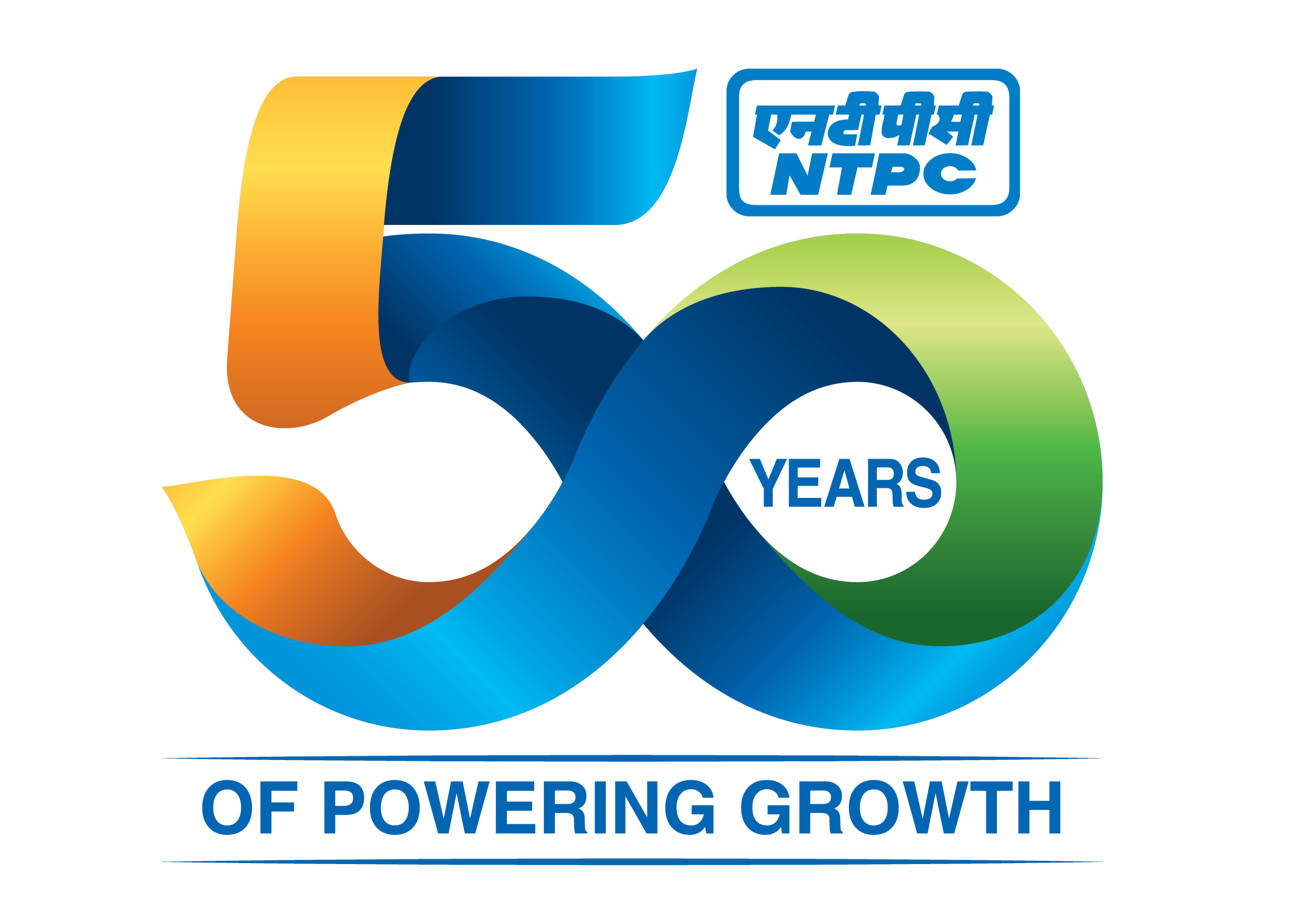Fabric Cutter
Entry Level Qualification
8
Career Fields
Apparel & Accessories
For Specially Abled





Career Entrance Exam
About Career
1. As a Fabric Cutter, you will be responsible for cutting bulk fabric, with precision, manually or with the help of an electrical fabric cutter. These fabrics may be for garments, upholstery, home furnishings, or other textile products.
2. You will be responsible for cutting out parts from cloth, canvas, etc., and other articles that will be sewn together, after spreading single/multiple layers of cloth, or fabric on a table or cutting board. You will be placing a pattern on a given material and marking the outlines of the pattern with chalk. You need to place the patterns appropriately on the material to be cut so that the least amount of the material is wasted.
3. While cutting fabric, you need to take care of the pattern placement, and several specifications like measurement lines, designs, notches, etc. You will also need to verify and match things like fabric color (with the detail sheets provided to you), and fabric width and then start cutting the fabric to give it a final shape.
Key Roles and Responsibilities
As a Fabric Cutter, you will be performing all or some of the following roles and responsibilities:
1. Ensure proper categorization of fabric depending on size, type, weight, color, condition, or shade.
2. Selecting matching fabrics and discarding those with defects such as spots, scars, stains, or scratches.
3. Marking measurement lines around templates or patterns, following layout points, using rules, chalk, pencils, etc.
4. Cutting, shaping, and clipping bulk fabric and textiles, with precision, manually or with the help of an electrical fabric cutter, other hand tools, portable power tools, or bench-mounted tools.
5. Folding or shaping fabric before or after cutting them.
6. Trimming excess material or cutting threads off finished products like removing loose ends etc.
7. Marking identification numbers, grades, or trademarks, etc. on fabric.
8. Checking and testing all cutting tools before and after starting your work.
PARTICULARS | DESCRIPTION |
Name | Fabric Cutter |
Purpose | Cutting, Shaping, and Clipping |
Career Field | Apparel & Accessories |
Required Entrance Exam | No Entrance Exam |
Average Salary | 40000 - 150000 Rs. Per Year |
Companies For You | Fabric Repairer, Fabric Checker, and Fabric Cutter & Many More |
Who is Eligible | Any One |
Career Entry Pathway
Class 8 in school - CTS NSQF Level 4 Training for ‘Cutting and Sewing’ or related courses.
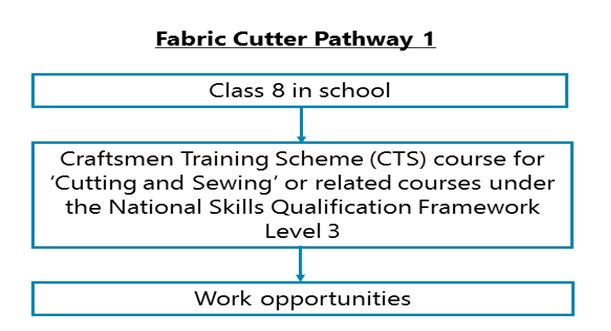
After completing Class 8 in school, you can enroll for the Craftsmen Training Scheme (CTS) course for ‘Cutting and Sewing’ or related courses under the National Skills Qualification Framework Level 3. This is a 1-year course with 2 semesters of 6 months each. You need to be at least 18 years of age to join these courses.
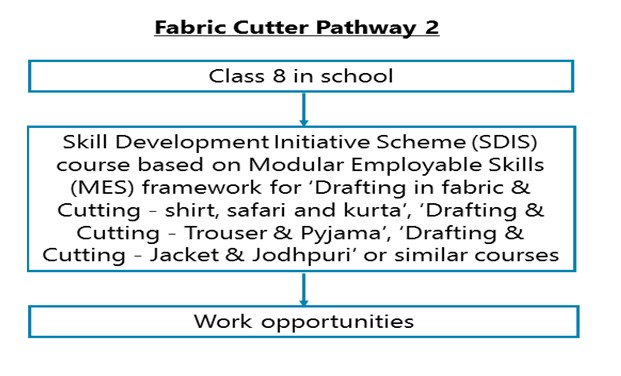
After completing Class 8 in school, you can enroll for Skill Development Initiative Scheme (SDIS) course for ‘Drafting in fabric & Cutting - shirt, safari, and kurta’, ‘Drafting & Cutting - Trouser & Pyjama’, ‘Drafting & Cutting - Jacket & Jodhpuri’ or similar courses based on Modular Employable Skills (MES) framework under the Ministry of Labour and Employment of India. You need to be at least 17 years of age to join these courses.
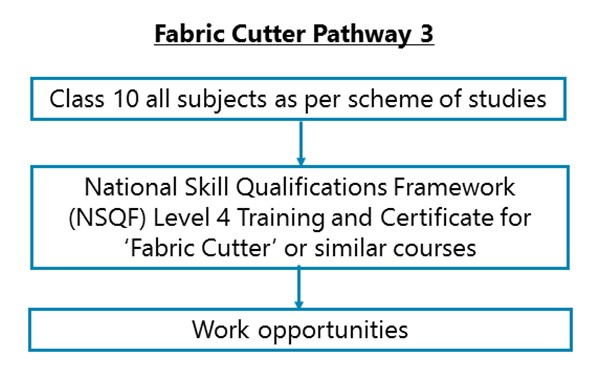
After Class 10, you need to undergo National Skill Qualifications Framework (NSQF) Level 4 Training and Certificate for ‘Fabric Cutter’ or similar courses. The total hours of training will be 300.
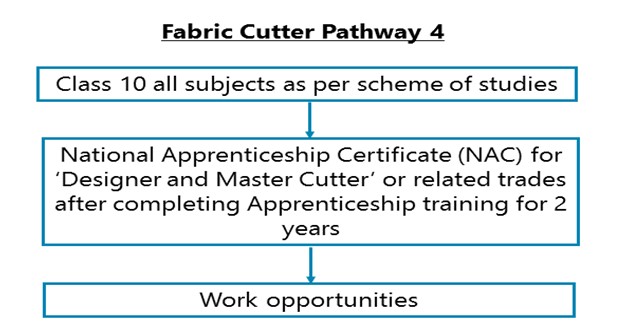
After Class 10, you can obtain a National Apprenticeship Certificate (NAC) for ‘Designer and Master Cutter’ or related trades after completing Apprenticeship training. Apprenticeship training will be for 2 years.
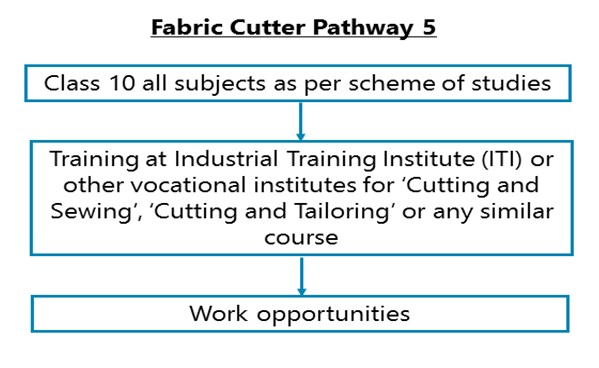
After Class 10, you need to undergo training at Industrial Training Institute (ITI), National Skill Training Institute (NSTI), Regional Vocational Training Institute (RVTI), National Vocational Training Institute (NVTI), Industrial Training Center (ITC) or other vocational institutes for ‘Cutting and Sewing’, ‘Cutting and Tailoring’ or any similar course. After completing this training, you will sit for the All India Trade Test (AITT) and you will get a National Trade Certificate (NTC) if you pass.
Required Qualification & Competencies
After Class 8 in school, you can go to:
1. CTS Training courses.
2. MES Training courses.
After Class 10, you can go for:
1. NSQF Level 4 Training courses.
2. NAC Training courses.
MINIMUM EDUCATION REQUIRED | MAXIMUM EDUCATION REQUIRED |
Under Secondary Certificate Programs for which the minimum eligibility is a pass in any class below class X. | Post-Secondary Certificate / Diploma Programs for which the minimum eligibility is a pass in class X. |
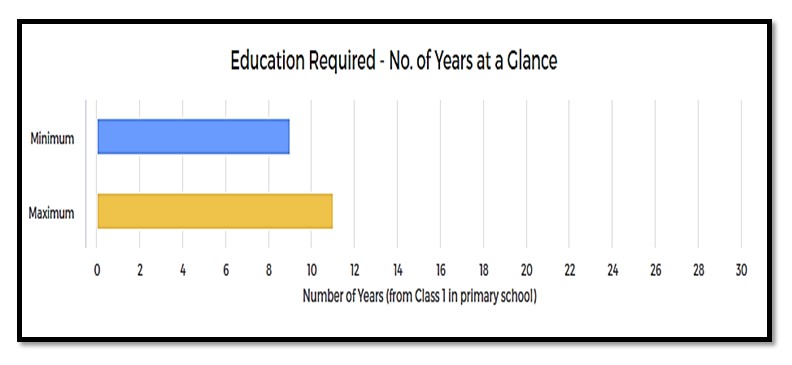
Competencies Required
1. You should have an interest in Realistic Occupations. Realistic occupations involve more practical and hands-on activities than paperwork or office work. Realistic occupations often involve physical activities for getting things done using various tools and equipment.
2. You should have an interest in Conventional Occupations. Conventional occupations involve repetitive and routine tasks as well as fixed processes or procedures for getting things done. These occupations involve working more with data, systems, and procedures and less with ideas or creativity.
3. You should know about Production and Processing - Knowledge of raw materials, production machinery, production systems, production processes, quality control, and other techniques for manufacturing or construction and distribution of goods.
4. You should have Process and Operation Controlling Skills - controlling processes and operations of various machines, equipment, devices, and systems using different types of electrical and electronic control instruments and systems.
5. You should have Time Management Skills - prioritizing work and managing time effectively.
6. You should have Finger Dexterity - The ability to make precisely coordinated movements of the fingers of one or both hands to grasp, manipulate, or assemble very small objects.
7. You should have Physical Stamina - The ability to exert yourself physically over long periods without getting winded or out of breath.
8. You should have Control Precision - The ability to quickly and repeatedly adjust the controls of a machine or a vehicle to exact positions.
9. You should have Arm-Hand Steadiness - The ability to keep your hand and arm steady while moving your arm or while holding your arm and hand in one position.
10. You are always or mostly careful about your actions and behavior.
11. You are practical always or in most situations.
12. You are always or mostly disciplined in your actions and behavior.
13. You are always or mostly organized in your day-to-day life and activities.
Career - Job Opportunities & Profiles
You will find work with various fashion designers or in textile and apparel establishments as a fabric repairer, fabric checker, and fabric cutter.
Career Growth
You can start as a Fabric Cutter and then grow to become a Fabric Repairer, Fabric Checker, Cutting Supervisor, Senior Craftsman - Production Planner, etc. With some years of work experience, you can also build your business and provide sales and services related to this fabric-cutting business.
Salary Offered
1. Salaries vary according to job profiles and the kind of facilities you get to work at.
2. In entry-level jobs: You may get about Rs. 3,000 – Rs. 10,000 or more per month.
3. Salaries increase with your work experience and as you get promoted.
4. After having 1-6 years of experience, you may expect about Rs. 7,000 – Rs. 15, 000 per month or more.
5. After having 6-12 years of experience, you may get about Rs. 12,000 – Rs. 25,000 or more per month.
6. In senior-level jobs, with 12-20 years of work experience, you may expect to get about Rs. 20,000 – Rs. 30, 000 or more per month.
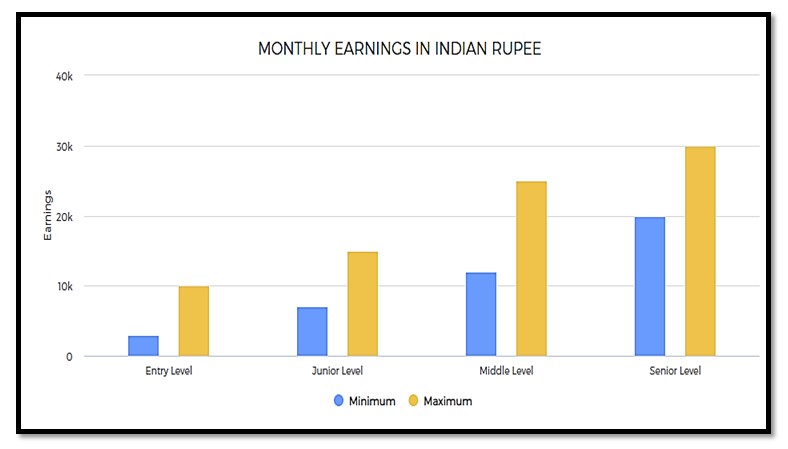
Monthly Earnings In Indian Rupee
Entry Level | Junior Level | Mid Level | Senior Level | ||||
Min Earning | Max Earning | Min Earning | Max Earning | Min Earning | Max Earning | Min Earning | Max Earning |
3000 | 10000 | 7000 | 15000 | 12000 | 25000 | 20000 | 30000 |
1. Entry level: 0 - 2 years of work experience
2. Junior Level: From 1 to 12 years of work experience
3. Mid-Level: From 5 to 20+ years of work experience
4. Senior Level: From 10 to 25+ years of work experience (there could be exceptions in some high-end technical, financial, engineering, creative, management, sports, and other careers; also shortly, people will reach these levels much faster in many careers and some careers, these levels will have no meaning as those careers will be completely tech skill driven such as even now, there is almost no level in a Cyber Security Expert’s job)
Work Activities
As a Fabric Cutter, you will be involved in one or more of the following activities:
1. Handling and moving objects and materials - Using hands or otherwise using physical strength to handle and move objects and materials; maneuver, install, lift, place, manipulate, etc.
2. Getting Information and learning - Observing, hearing, and reading using computers, or otherwise obtaining information and learning from it.
3. Performing physical activities - Performing physical activities that require the use of your arms and legs and moving your whole body, such as climbing, lifting, balancing, walking, stooping, and handling materials.
4. Identifying objects, actions, and events - Identifying various characteristics of objects; observing and understanding actions and events; understanding changes in actions and events.
5. Inspecting equipment, systems, structures, and materials - Inspecting equipment, systems, structures, and materials to ascertain quality, performance, defects, causes of errors, etc.
6. Organizing, planning, and prioritizing tasks - Planning and organizing tasks to achieve work goals; prioritizing tasks to achieve goals and making the best use of the time available.
7. Processing of information - tabulating, calculating, verifying, or otherwise dealing with information processing including recording, storing, and maintaining work-related information.
Future Prospects
1. The future of this pathway seems satisfying. India is the largest exporter of yarn in the global market. The overall volume of employment in the Handlooms and Handicrafts Sector is expected to reach about 17.79 million.
2. This sector is predicted to experience a shift to organized from an unorganized market model. Many small clusters of Handicrafts and Handlooms are being developed with the support of private traders/entrepreneurs. The Indian Retail market is expected to reach the mark of 865 billion US Dollars. Corporatized Retail in India is expected to grow 24%. A surge in online consumer base is also contributing to the expansion of this sector.
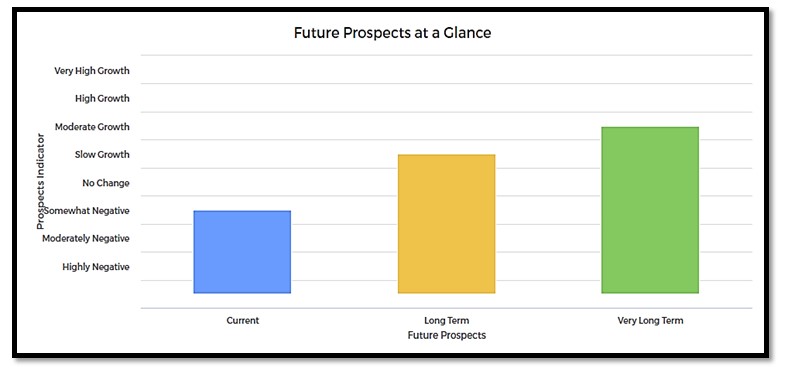
Future Prospects At A Glance
Current (0-1 year) | Long Term (2-5 years) | Very Long Term (6-10 years) |
Somewhat Negative | Slow Growth | Moderate Growth |
